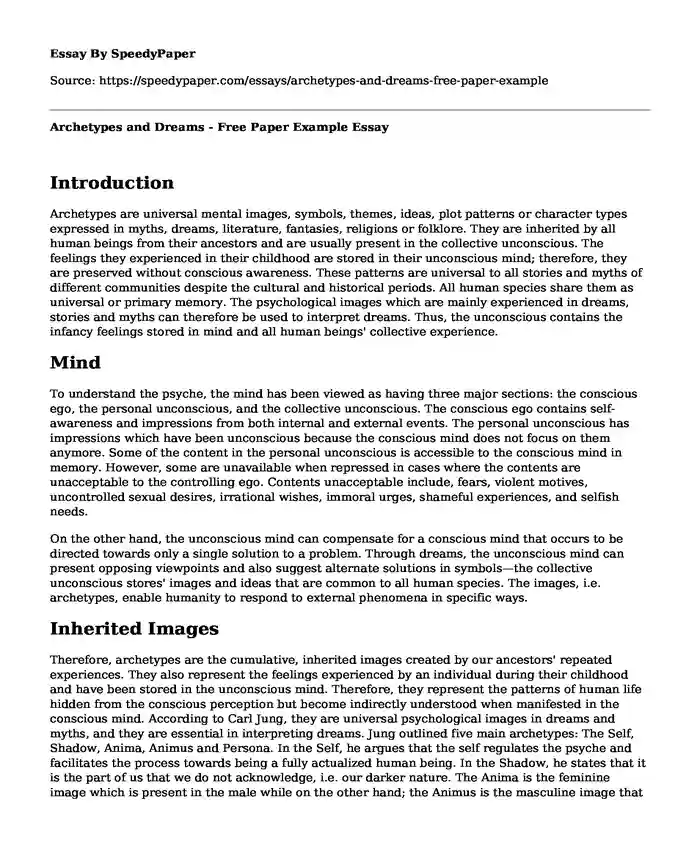
| Type of paper: | Essay |
| Categories: | Psychology Personality Mythology |
| Pages: | 3 |
| Wordcount: | 772 words |
Introduction
Archetypes are universal mental images, symbols, themes, ideas, plot patterns or character types expressed in myths, dreams, literature, fantasies, religions or folklore. They are inherited by all human beings from their ancestors and are usually present in the collective unconscious. The feelings they experienced in their childhood are stored in their unconscious mind; therefore, they are preserved without conscious awareness. These patterns are universal to all stories and myths of different communities despite the cultural and historical periods. All human species share them as universal or primary memory. The psychological images which are mainly experienced in dreams, stories and myths can therefore be used to interpret dreams. Thus, the unconscious contains the infancy feelings stored in mind and all human beings' collective experience.
Mind
To understand the psyche, the mind has been viewed as having three major sections: the conscious ego, the personal unconscious, and the collective unconscious. The conscious ego contains self-awareness and impressions from both internal and external events. The personal unconscious has impressions which have been unconscious because the conscious mind does not focus on them anymore. Some of the content in the personal unconscious is accessible to the conscious mind in memory. However, some are unavailable when repressed in cases where the contents are unacceptable to the controlling ego. Contents unacceptable include, fears, violent motives, uncontrolled sexual desires, irrational wishes, immoral urges, shameful experiences, and selfish needs.
On the other hand, the unconscious mind can compensate for a conscious mind that occurs to be directed towards only a single solution to a problem. Through dreams, the unconscious mind can present opposing viewpoints and also suggest alternate solutions in symbols—the collective unconscious stores' images and ideas that are common to all human species. The images, i.e. archetypes, enable humanity to respond to external phenomena in specific ways.
Inherited Images
Therefore, archetypes are the cumulative, inherited images created by our ancestors' repeated experiences. They also represent the feelings experienced by an individual during their childhood and have been stored in the unconscious mind. Therefore, they represent the patterns of human life hidden from the conscious perception but become indirectly understood when manifested in the conscious mind. According to Carl Jung, they are universal psychological images in dreams and myths, and they are essential in interpreting dreams. Jung outlined five main archetypes: The Self, Shadow, Anima, Animus and Persona. In the Self, he argues that the self regulates the psyche and facilitates the process towards being a fully actualized human being. In the Shadow, he states that it is the part of us that we do not acknowledge, i.e. our darker nature. The Anima is the feminine image which is present in the male while on the other hand; the Animus is the masculine image that attributes within the woman. In the Anima, it has been said the soul of man is feminine, whereas, in the Animus, the soul of the female is masculine. Lastly, he outlines that the Persona is our mas which is what the world sees as being our self.
The prominent examples of Archetypes are family archetypes, story archetypes and animal archetypes. Family Archetypes involve the father who is seen as stern, powerful and controlling, with the mother being nurturing and soothing and the child’s birth, beginning and salvation being outlined. In Story Archetypes, there is a hero, maiden, wise older adult, magician, witch or trickster. Usually, the hero is a rescuer or champion, maiden portrays purity and desire, the wise older man is viewed as knowledgeable and offers guidance, the magician is mysterious and powerful, the witch is dangerous, and the trickster is involved in deceit. Animal Archetypes involve a faithful dog that portrays unquestioning loyalty, and an enduring horse that never gives up, or a devious cat that is self-serving.
Archetypes often involve heroes, the protagonists, which are in some archetypal journey in which they encounter different situations and symbols before they complete their tasks or quest. Heroic archetypes include warriors, lovers, scapegoats, feminists and superheroes. The journeys are often questing for identity, vengeance, rid the land out of danger, tragic quests or human perfection, search for love, knowledge, or epic journeys. The journeys involve departure, initiation, the road of trials, the innermost cave, and return and reintegration with society on completion of the journey.
Conclusion
Therefore, archetypes are an essential element in our conscious mind. They bring meaning to what is already stored in unconscious memory from our infancy emotions and experiences of the entire human race. They are essential in interpreting dreams as the archetypes are often expressed in dreams and myths. We should, therefore, appreciate their role in our daily experiences.
Cite this page
Archetypes and Dreams - Free Paper Example. (2023, Nov 24). Retrieved from https://speedypaper.com/essays/archetypes-and-dreams-free-paper-example
Request Removal
If you are the original author of this essay and no longer wish to have it published on the SpeedyPaper website, please click below to request its removal:
- Reflective Essay Sample: Team Management
- Free Essay Sample on Workplace Mobbing
- Social Phobia Essay Example
- Understanding Barriers to Gender Equality Essay Sample
- Case Study Paper Example on Body Modification of Maria Jose Cristerna
- Free Essay on Addiction Counselor Competencies
- Free Essay Sample on Benefits Package With the HR Manual
Popular categories




